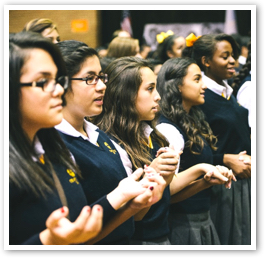A dynamic model for Catholic Education
- ASHLEY BATEMAN
Cristo Rey schools provide an exemplary model, one that is growing and expanding and could revitalize the realization of Catholic schools nationwide.
 Faith-based education institutions are closing as quickly as alternative education options open; charter school students now outnumber those enrolled in Catholic schools as government funding streams recognize reform and innovation in the public sector. The crux of Catholic education is to serve and affect social change, but public funding rarely recognizes the long-term positive effects of this mission. In some states, tax credit scholarships, education savings accounts and voucher programs have allowed for state funding of private education in some locales, but most programs are still in their infancy and growth is slow.
Faith-based education institutions are closing as quickly as alternative education options open; charter school students now outnumber those enrolled in Catholic schools as government funding streams recognize reform and innovation in the public sector. The crux of Catholic education is to serve and affect social change, but public funding rarely recognizes the long-term positive effects of this mission. In some states, tax credit scholarships, education savings accounts and voucher programs have allowed for state funding of private education in some locales, but most programs are still in their infancy and growth is slow.
Nationally, many major education indicators depict growing disparities in educational opportunities. Students of color drop out of school at a significantly higher rate than their peers. While 80 percent of students graduate statewide, only 60 percent of students defined as English learners graduate.
Catholic schools' mounting tuition costs over the years, rising from a lower number of religious men and women working in schools free of charge, have made them less accessible, even to those of means. But new, innovative instructional models that integrate technology to improve students' learning efficiencies could slow, and even reverse, the negative trend of Catholic school growth and enrollment.
One Catholic school network opened a new school in California's Silicon Valley this fall; San Jose Jesuit, a Cristo Rey school, has created a smart, sophisticated technology learning model to enhance and empower teacher instruction, while exclusively serving underprivileged youth. The school provides a college-preparatory high school education at a fraction of the cost. The Network boasts a 100 percent graduation rate and 90 college enrollment rate while providing students professional experience by contracting with local companies.
According to Joe McTighe, executive director for Council for American Private Education, Cristo Rey is utilizing an "entrepreneurial spirit and vision," to demonstrate the realization of sustainable reform.
Allotting time for its powerfully-effective work study program (students work one day a week as paid employees for local businesses) has meant lengthening of the traditional school day and year at most Cristo Rey Network schools, making up for missed classroom time.
San Jose Jesuit is directing a sustainable course through the Catholic education landscape. Private support is no longer enough to preserve Catholic education, but harnessing quality technology tools could provide long-term answers to sustainability.
 Students at San Jose Jesuit are showing incredible mastery of subjects, particularly math, in a short amount of time. On average, students grew a grade level and a half on end of summer assessments, averaging a 7.4 grade level equivalency on the first day and 8.9 on the last day.
Students at San Jose Jesuit are showing incredible mastery of subjects, particularly math, in a short amount of time. On average, students grew a grade level and a half on end of summer assessments, averaging a 7.4 grade level equivalency on the first day and 8.9 on the last day.
The school ensures the use of quality computer-based programs that are student-focused but oftentimes teacher-driven or reliant on teacher oversight.
High-quality, strategically-implemented blended learning models address student skill gaps and ensure course mastery; real-time feedback throughout each course pinpoints student issues so teachers can provide instruction to meet individual learning needs efficiently and effectively.
"It appears to me that the future of education has got to take technology in stride," said John Sobrato, Silicon Valley businessman and one of the school's founders. "Larger class sizes can work utilizing technology and thereby reduce overhead costs and at the same time provide individualized instruction with real-time feedback to the teacher."
Blended learning director at San Jose Jesuit, Francisco Castillo-Fierro, spent a year researching and collaborating with school leaders at San Jose Jesuit to ensure that the school's infrastructure would support a successful blended learning environment. He found that the most successful blended models employed a highly-qualified tech individual or team, to research and deploy blended learning programs. Finding educators who will commit to extended hours and a lower-than-average salary can be a challenge in Catholic education communities; but teachers who sign on tend to carry a commitment to and real belief in the Catholic mission.
Cristo Rey provides an exemplary model, one that is growing and expanding and could revitalize the realization of Catholic schools nationwide.
"I'm always looking to see where there is leverage to make an investment to reap multiples," said BJ Cassin, Catholic education champion and businessman who co-chairs the school's board. "We're a long way from saying this is the model everyone should use but we've made an investment in blended learning and the hope is we can figure it out and offer it to the rest of the schools."
 This is Meaghen Gonzalez, Editor of CERC. I hope you appreciated this piece. We curate these articles especially for believers like you.
This is Meaghen Gonzalez, Editor of CERC. I hope you appreciated this piece. We curate these articles especially for believers like you.
Please show your appreciation by making a $3 donation. CERC is entirely reader supported.

Acknowledgement
 Ashley Bateman. "School Choice Is Making Stunning Gains, Vote To Encourage Them." The Daily Caller (November 3, 2014).
Ashley Bateman. "School Choice Is Making Stunning Gains, Vote To Encourage Them." The Daily Caller (November 3, 2014).
Reprinted with permission of the author.
The Author
 Ashley Bateman, an adjunct scholar with the Lexington Institute, has written extensively about education reform in the United States. She is the author of The Cristo Rey Network: Serving Sustainable Success. Available here.
Ashley Bateman, an adjunct scholar with the Lexington Institute, has written extensively about education reform in the United States. She is the author of The Cristo Rey Network: Serving Sustainable Success. Available here.




